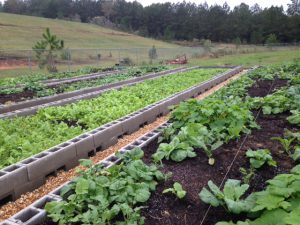
The Heat Won’t Last: Plan Now for Fall Greens
 The heat and humidity of August is upon us, the cool of fall seems very far away, but is it? Believe it or not, now is the time to start planning fall vegetable gardens.
The heat and humidity of August is upon us, the cool of fall seems very far away, but is it? Believe it or not, now is the time to start planning fall vegetable gardens.
One of the most popular fall vegetables throughout the lower southern states are greens. There are old stand-bys such as cabbage, mustard, turnip and collard, but also more novel selections such as kale, and rainbow Swiss chard. One technique to extend the cropping season of collards and kale, is harvesting only lower leaves while allowing plants to continue to grow, instead of harvesting entire plants. If several plants of each are planted, there will be enough for a family to have a continuous supply of greens through the season.
Most greens prefer a pH of 6.0 to 6.5, but will tolerate pH in the range of 5.5 to 7.0. If pH is too low, the rate of dolomitic per hundred square feet to raise pH one point is 2-3 lbs. Dolomitic lime must be added at least two months before planting to be effective. Greens may be fertilized with a variety of products from compost (at the rate of 20 lbs. per 100 sq. ft.) to 10-10-10 (at the rate of 2-3 lbs. per 100 sq. ft.) balanced fertilizer with micronutrients. Two to three light repeat applications in the soil at the leaf’s edge may be warranted if plants show a need.
Starting in late August, if the weather is not blisteringly hot, collards may be started by direct seeding. If hot days are excessive, it may be necessary to drop a shade cloth on young plants until weather cools. This will improve development in the event of extended heat in early September. It is also necessary to water regularly and thoroughly while making sure plants are well-drained.
In mid-September, kale, Swiss chard, turnip greens, mustard greens and cabbage may be planted. It is often an advantage to stagger plantings from September through December to extend the season.
Greens can be planted by either direct seeding or transplanting. I have found that if starting greens when it is still very warm, direct seeding is desirable since more transplant shock occurs when temperatures are higher. When it is cooler, transplanting may be more advantageous since the plants will be more developed and ready to harvest sooner.
Greens make a delightful addition to any meal so why not grow your own and experiment with novel types that cannot be found in store shelves. The video below details some novel techniques used to maximize greens’ harvest. Happy Gardening.
Video: Greens and Lettuce for Fall Gardening
Florida Vegetable Gardening Guide
